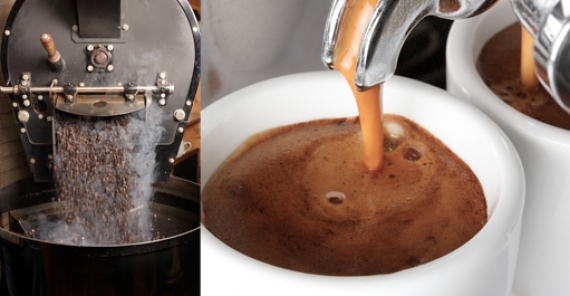As it’s the beans needed to make coffee, the fruit is removed in one of two ways. The preferred method is by soaking the cherries, producing ‘washed coffees’. The length of soaking will depend on the producer. The fruit can also ‘sun-dried’ or dried in a dryer, before being separated from the bean in a husker. Once dried, sorted and graded, usually by hand, the green beans are ready for roasting into the more familiar dark brown beans, ready for use. It is in this ‘green’ form, the beans are normally shipped around the world.
There are two main types of coffee bean – Arabica and Robusta.
- Arabica – around 80% of the world’s coffee production is arabica. It produces a superior coffee with better flavour and aromatic qualities.
- Robusta – robusta trees are easier to grow, more disease resistant and produce higher yields. Robusta beans contain twice as much Caffeine and have a more bitter flavour. They tend to be used in lower-priced coffees, or as a small proportion of espresso blends as they produce coffee with richer crema.
Roasting
Roasting coffee beans is both an art and science, transforming a bland green-coloured bean into a rich roast. Roasting unlocks aromatic ‘oils’ by caramelising sugars and starches. These so-called oils are not technically oils because they are water-soluble, but give the coffee flavour and aroma. Coffee can be roasted in two ways – turning in a drum over a flame or tumbling through hot air. Either way, the beans are generally roasted around 180-200°C.
1st stage: Roasting begins by turning the green beans yellow. As the beans dry out, they turn yellow and begin to smell like toast.
2nd stage: Known as the first crack, gas builds up inside the beans, causing them to swell and rupture. At this stage, they are light brown in colour and have a wrinkled surface.
3rd stage: The beans are now losing weight – a 7kg bag of beans will weigh around 6kg when roasted. They are also expanding in size, deepening in colour and the skins are becoming smooth. It can be just matter of minutes before the second ‘crack’ is heard. This stage requires careful monitoring to ensure the beans aren’t ‘overcooked’. The beans may have an oily sheen as oils rise to the surface. Beyond this point, the beans may smoke as the sugars carbonise.
The roaster must use his skill and judgement to stop roasting at just the right moment, and release the beans into a cooling vat to prevent any further cooking.
Roasting takes about 25-30 minutes depending on the weather conditions. Roasting times increase with humidity, as the beans absorb more water in the damper conditions, taking slightly longer to dry out. The beans will continue to give off vapours, mainly carbon dioxide, for a day or two before reaching their optimal flavour.
We roast every day at Caffé Massimo ensuring a continuous supply of beans in the perfect state of readiness for your daily needs, both in the café and at home. Roaster’s tip: When grinding your own coffee at home, grind the beans to a slightly coarser size in the humid weather, as the beans will be stickier.

